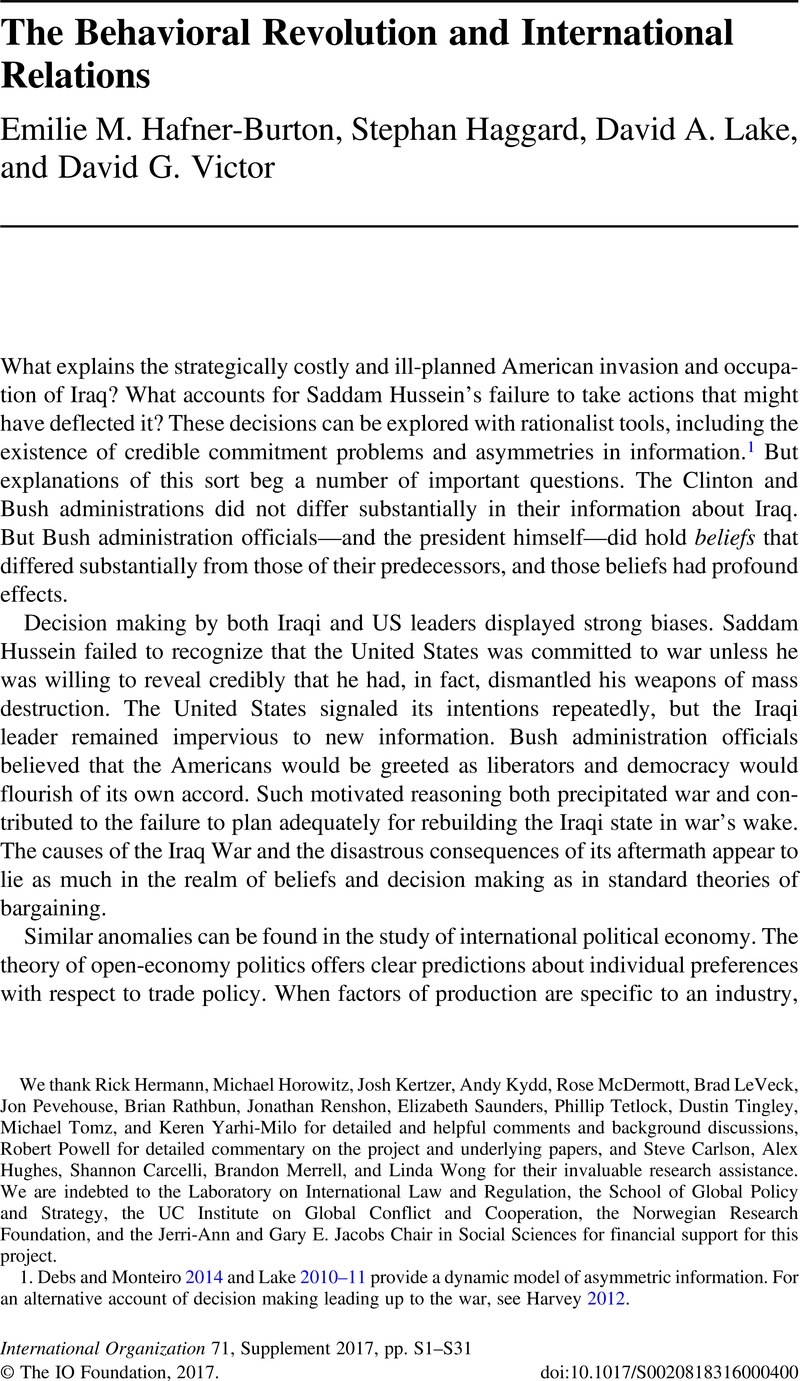Crossref Citations
This article has been cited by the following publications. This list is generated based on data provided by Crossref.
Renshon, Jonathan
Lee, Julia J.
and
Tingley, Dustin
2017.
Emotions and the Micro-Foundations of Commitment Problems.
International Organization,
Vol. 71,
Issue. S1,
p.
S189.
Rho, Sungmin
and
Tomz, Michael
2017.
Why Don't Trade Preferences Reflect Economic Self-Interest?.
International Organization,
Vol. 71,
Issue. S1,
p.
S85.
Bayram, A. Burcu
2017.
Due Deference: Cosmopolitan Social Identity and the Psychology of Legal Obligation in International Politics.
International Organization,
Vol. 71,
Issue. S1,
p.
S137.
Fuhrmann, Matthew
2017.
When Do Leaders Free-Ride? Business Experience and Contributions to Collective Defense.
SSRN Electronic Journal ,
Rathbun, Brian C.
Kertzer, Joshua D.
and
Paradis, Mark
2017.
Homo Diplomaticus: Mixed-Method Evidence of Variation in Strategic Rationality.
International Organization,
Vol. 71,
Issue. S1,
p.
S33.
Kertzer, Joshua D.
2017.
Resolve, Time, and Risk.
International Organization,
Vol. 71,
Issue. S1,
p.
S109.
Friedman, Jeffrey A.
Lerner, Jennifer S.
and
Zeckhauser, Richard
2017.
Behavioral Consequences of Probabilistic Precision: Experimental Evidence from National Security Professionals.
International Organization,
Vol. 71,
Issue. 4,
p.
803.
Powell, Robert
2017.
Research Bets and Behavioral IR.
International Organization,
Vol. 71,
Issue. S1,
p.
S265.
Herrmann, Richard K.
2017.
How Attachments to the Nation Shape Beliefs About the World: A Theory of Motivated Reasoning.
International Organization,
Vol. 71,
Issue. S1,
p.
S61.
Shirkey, Zachary C.
2018.
Introduction: The Puzzle of War Duration.
Polity,
Vol. 50,
Issue. 2,
p.
162.
Kertzer, Joshua D.
and
Tingley, Dustin
2018.
Political Psychology in International Relations: Beyond the Paradigms.
Annual Review of Political Science,
Vol. 21,
Issue. 1,
p.
319.
Walker, Hayley
2018.
Mutual Recognition in Global Negotiations: The Case of the 2015 Paris Climate Summit.
SSRN Electronic Journal ,
Bourbeau, Philippe
2018.
On Resilience.
Flynn, D.J.
Horiuchi, Yusaku
and
Zhang, Dong
2018.
Misinformation, Economic Threat, and Public Support for International Trade.
SSRN Electronic Journal ,
Terhalle, Maximilian
2018.
Strategie und Strategielehre.
Zeitschrift für Außen- und Sicherheitspolitik,
Vol. 11,
Issue. 1,
p.
83.
Bearce, David H.
and
Cook, Thomas R.
2018.
The first image reversed: IGO signals and mass political attitudes.
The Review of International Organizations,
Vol. 13,
Issue. 4,
p.
595.
Smetana, Michal
and
Onderco, Michal
2018.
Bringing the outsiders in: an interactionist perspective on deviance and normative change in international politics.
Cambridge Review of International Affairs,
Vol. 31,
Issue. 6,
p.
516.
Brutger, Ryan
and
Kertzer, Joshua D.
2018.
A Dispositional Theory of Reputation Costs.
International Organization,
Vol. 72,
Issue. 3,
p.
693.
McLean, Elena V
and
Radtke, Mitchell T
2018.
Political Relations, Leader Stability, and Economic Coercion.
International Studies Quarterly,
van Aaken, Anne
2018.
Behavioral Aspects of the International Law of Global Public Goods and Common Pool Resources.
American Journal of International Law,
Vol. 112,
Issue. 1,
p.
67.





